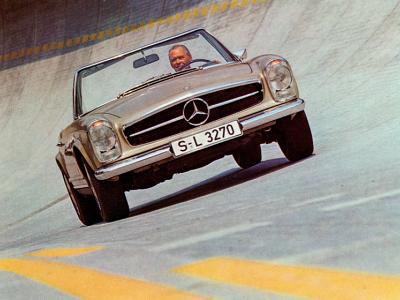 The W113 Pagodas were designed to bring the performance of the mighty 300SL and the affordability of the 190SL together with contemporary looks, handling and safety. Styled by the great Paul Bracq, the striking result became a modern classic.
The W113 Pagodas were designed to bring the performance of the mighty 300SL and the affordability of the 190SL together with contemporary looks, handling and safety. Styled by the great Paul Bracq, the striking result became a modern classic.
A Modern Classic
The 1963-1971 230SL, 250SL & 280SL W113 Pagodas
Article Michael Salemi
Images Daimler Archives
The W113 was conceived in October 1958 when the initial proposal was approved to replace both the 190SL and 300SL. Both 300SL models were handmade, costly and rare; the 190SL was an affordable substitute, but all were destined for retirement by 1963. The new vehicle would feature advanced safety-body construction, pioneered by engineer Béla Barényi.
The W113 was a clean-sheet design borrowing almost nothing but broad-brush concepts from earlier SLs. It did, though, borrow many parts from existing sedans. Chief engineer Rudolf Uhlenhaut’s plan for the W113 was simple: marry performance characteristics of the 300SL with the production capability and affordability of the 190SL; package with modern styling, improved handling and evolving safety engineering. It was a difficult undertaking to replace an already legendary car with racing pedigree, along with superseding its more popular and pedestrian sibling. Few knew what might emerge.
While engineers worked on the new safety body, the styling team sketched concepts; by March 1959, Paul Bracq’s renderings still bore a great resemblance to the 190SL/300SL siblings. A new direction emerged in February 1960 when chief stylist Friedrich Geiger drafted a new concept considerably different than his team’s idea. Bracq was handed the sketch and refined it, and by April 1960, his adaptation revealed the main body design and style in now-familiar form. The hardtop would evolve separately.
That hardtop was a design collaboration between Barényi and Bracq; its concave style is unusually strong while providing surprisingly easy entry and egress. Resembling Japanese temple architecture, the hardtop’s appearance inspired its nickname. For their achievement, Bracq and Barényi were issued U.S. patent No. 3,169,793 for “Motor vehicle with a concave top” in 1965. We just call it the Pagoda.
The new 230SL was revealed at the 1963 Geneva Motor Show to an underwhelmed motoring press. Despite impeccable engineering, better handling, vastly improved road manners, a modern look, greater comfort and visibility over its predecessors, it failed to impress those used to the sexy, curvaceous, powerful – and elitist – 300SL. No matter: The press corps is a small lot, and Daimler-Benz management knew there were new markets to conquer. The elegant and sporty car proved popular. Today, the Pagoda remains eminently drivable and a favorite among collectors.
Reasons to buy a W113 Pagoda SL
It is rolling sculpture: Modern, tasteful and timeless, the Pagoda consistently turns heads and evokes smiles.
It wants to be driven; the fuel system doesn’t like being idle.
A well-sorted Pagoda is reliable and comfortable on long-distance drives; it keeps up with modern highway traffic.
An enthusiast with reasonable skills can do maintenance.
Most parts are available from the Classic Center and other sources; many reproduction parts are available because some were sourced from sedans produced in great volumes.
Many repair and restoration experts are in the United States and Canada for major maintenance, parts or restoration.
The Pagoda SL Group Inc. (www.sl113.org) is an incredible, friendly, international group of owners and enthusiasts who happily share their knowledge and experience with one another: It’s in their charter and raison d’etre.
Reasons not to buy a W113 Pagoda SL
Recent skyrocketing prices for both cars and parts are making all three models expensive to buy and insure, and costly to properly maintain.
Rising values make owners reluctant to drive the car where it can’t be secured; some feel the car is too valuable to use.
The increase in prices has brought many needy and long-neglected cars to market. Beware, as there is nothing more costly than a poorly bought Pagoda.
Driven by steeply rising parts prices and increasing values, restoration costs are climbing rapidly.
These cars can be loud. A stock Pagoda is turning nearly 4,000 rpm at contemporary traffic speeds, making driving at highway speeds a noisy experience. Some owners have remedied this by fitting a lower-ratio differential from sedans of the era, and/or fitting a modern 5-speed transmission to create overdrive.
Checkpoints
Look carefully for evidence of body repair. Most body sheet metal is available, but some parts such as the aluminum hood and trunk are costly. Extensive rust hidden in the unitized chassis can be irrepairable. Repair work performed to very high standards by Pagoda experts can be very costly.
Check engine and accessory operation. Most replacement mechanical parts are available, some reasonable and others expensive. The Bosch mechanical fuel-injection pump is reliable and robust, but time consuming to set up properly. Rust and corrosion can be damaging to the fuel-injection system, including the injection pump and fuel injectors.
Documented history of the car – including ownership, repairs and restoration(s), if any – is critical to a successful purchase; so is a prepurchase inspection by an expert.
Completeness is essential; familiarize yourself with what a complete car looks like and ensure your candidate has all its parts. It can be time consuming and maddening, if not expensive, to find small missing trim or interior pieces.
Buying tips
Research the history and details of the model using published and online resources and show examples of the cars.
Join the Pagoda SL Group Inc. Owners, enthusiasts and professional experts participate in the online forum. They have a wealth of knowledge and a willingness to share it. The website is a resource for parts, vendors and other expertise.
Get an expert’s help if you are serious about buying one of these cars. Making a mistake can be very costly.
With prices rising, many poorly maintained examples have emerged from storage. These will cost dearly to restore. Be wary and use all the tools at your disposal to weed through the chaff.
Finally
We may not have seen the end of price increases. A well-sorted, well-purchased Pagoda might just provide you with the most rewarding experience of owning a gorgeous collectible car that you can drive – and one that will continue to gain in value.
Comparing All Three
To the untrained eye, all three Pagoda models look identical. Aside from the engine changes (2.3L to 2.5L, and then to 2.8L), the differences are subtle but important to those who understand them.
Earlier 230SLs are more expensive to restore than later models, due to scarcity of some parts and the cost of others. Some prefer the 230SLs, feeling that as the first of the breed, they are the purest example. They are lighter and provide a more nimble driving experience.
The 250SL is the rarest, made for just 11 months. However, the market has not rewarded this rarity with any marked price differential. Lovers of the 250SL enjoy this exclusivity and also like the fact that the car is relatively unburdened by the emissions and safety additions of the 280SL, while showing purity in detail and more chrome trim.
Owners of the 280SL often cite it as preferable because it had all the changes from the factory, including the latest safety gear such as “bumperettes” and headrests; price a bumper and you’ll see why this is important! The market assigns the greatest values to the 280SLs.
This trio of models isn’t the only version of the class; there are European and U.S. models for each. Differences are subtle, with varying cams, and H4 lighting on Euro models set against SAE sealed beams on U.S. models. Some prefer the Euro model – for purity – while others are happy with SAE lighting and stock U.S. performance.
One thing is certain: There is no pecking order. Owners of all models get along well and enthusiasts respect and celebrate the differences. You will agree if you attend a meeting of Pagoda owners. You’ll also marvel at the amazingly broad color palette of these cars compared with today’s mostly black, white and silver.
Technical Specifications: 1963-1971
U.S. Market W113 230SL, 250SL & 280SL Pagoda
Model Model Years Engine HP Torque Transmissions Rear Axle
230SL 1963-1967 2.3L I-6 150 145 4-M | 4-A | ZF 5-M 3.92:1
250SL 1967-1968 2.5L I-6 150 159 4-M | 4-A | ZF 5-M 3.92:1
280SL 1968-1971 2.8L I-6 170 180 4-M | 4-A | ZF 5-M 4.08:1
Model 0-62 mph Top Speed MPG [US]
230SL 11 | 13 | 9.7 sec 120 15.7
250SL 12 | 13 | 9.7 sec 121 14.7
280SL 11 | 12 | 9.0 sec 124 14.3
Chronology
1963 March: 230SL introduced at Geneva Auto Show
May: 230SL production begins
1964 August: Wheel width increased from 5.5 to 6 inches
November: Spare-tire well removed; tire mounted horizontally
1965 July: Exhaust manifold changed from sheet steel to cast iron;
exhaust headpipes changed to cast iron
August: Horn ring changed from round to flattened-top segment
1966 November: 250SL production begins
Coupe-only version with rear bench seat introduced;
fuel tank increased to 82 liters; rear disc brakes introduced;
front anti-roll-bar diameter decreased from 22 to 20 mm;
instrument panel one-piece rather than split
1967 August: New rear and side-view mirrors;
side reflectors added to fenders; matte chrome on many parts
November: 280SL production begins
Firewall insulation pad changed from coarse to smooth; no mirror
in passenger sun visor; heater and air-vent levers now rubber;
legend plates added to light switch, heater controls; emergency
flasher now standard; synthetic carpet replaces rubber floor mats;
headrests added to seats; wheel covers now one piece
1969 February: Side marker lights replace reflectors; amber rear directionals
1970 August: Ignition transistorized; wheels pierced with round holes
1971 February: 280SL production ends
Production
Model Year Total
230SL 1963-1967 19,831
250SL 1966-1968 5,196
280SL 1968-1971 23,885
Value Guide (courtesy SL Market Letter)
Model Model Years Low Medium High
230SL 1963 – 1967 $18,800 $38,150 $57,500
250SL 1967 – 1968 $19,850 $45,850 $82,500
280SL 1967– 1969 $26,775 $55,900 $89,000
280SL 1970– 1971 $28,900 $56,700 $110,000
Add $4,000 for ZF 5-Speed. Subtract $4,500 for coupe/hardtop only.
Add $1,500 for both tops in good condition. Add $1,500 for working a/c.
Add 40-60 percent for first-rate restoration, rarely driven show car or preserved original survivor.
Caption Information
Appearing in 1963, the 230SL had unfamiliar proportions and a new silhouette. Although some details, such as the vertical main headlights, carried over from the iconic 300SL Roadster, the Pagoda was a crisp, modern interpretation of the classic open-topped motoring theme. Here a 280SL undergoes testing in 1968.
TOP: The unmistakable pagoda roof, seen on a 280SL. The removable hardtop is not only remarkably attractive, its shape and slightly lower midsection increases the stiffness – and safety – of the roof. ABOVE: A 280SL under canvas – the fabric top offered a quick fix for inclement weather while preserving fine proportions.
